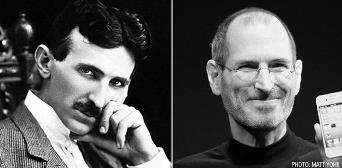 Following Steve Jobs’ recent death, the debate was sparked soon after about his rank among inventors in American lore. Free Enterprise.com recently surveyed its Facebook followers on the matter, with some interesting results. The “odd facts” about Jobs and Nikola Tesla are likely the best part. (And if you visit the link above, be sure to read the somewhat profane, yet comically scathing rebuke of Thomas Edison):
Following Steve Jobs’ recent death, the debate was sparked soon after about his rank among inventors in American lore. Free Enterprise.com recently surveyed its Facebook followers on the matter, with some interesting results. The “odd facts” about Jobs and Nikola Tesla are likely the best part. (And if you visit the link above, be sure to read the somewhat profane, yet comically scathing rebuke of Thomas Edison):
We got hundreds of responses and found an interesting difference between the men and the women. The overwhelming majority of male respondents (81%) said engineer, physicist and futurist Nikola Tesla was the greatest innovator of the last 100 years (maybe our male Facebook followers are fans of The Oatmeal?). Facebook follower Jason Carter notes, “He IS the father of the information and the industrial age.” R. Keith Hunter responded, “Without him, we would not be technologically where we are today.”
Female respondents gave Apple guru Steve Jobs a slight edge, with 55% of women saying he was the greatest innovator. Barbara Spitznogle explained her vote, “He changed our world with his brilliant ideas and he applied them to our daily lives.”
Inventor Thomas Edison and Microsoft’s Bill Gates tied for third place among all respondents, while automotive pioneer Henry Ford was a solid fourth.
Here’s a bit more about the top two greatest innovators of the last 100 years, as decided by voters on the American Free Enterprise Facebook page.
Nikola Tesla
Tesla was born the son of a Serbian Orthodox priest in Smiljan, Croatia. He credited his innovative quest to his mother, a homemaker who created appliances such as a mechanical eggbeater to help with the home and farm. He emigrated to the United States at 26 years old and worked for Thomas Edison, who eventually became Tesla’s rival.
The list of inventions that Tesla pioneered reads like the history of the 20th century: Radio, radar, the induction motor, the Tesla coil, alternating current dynamos, arc light systems, and electric vehicles were all conceived by Tesla. He also developed concepts such as the use of X-ray machines, telegeodynamics, robotics, and early computer-logic principles.
Fun Fact: Tesla held over 700 patents in 26 countries when he died in New York in 1943.
Odd Fact: Nikola Tesla claimed to have invented a death ray which he called teleforce in the 1930s and continued the claims up until his death
Steve Jobs
Jobs was born in San Francisco in 1955, and adopted by Paul and Clara Jobs of Santa Clara, Calif.Jobs attended high school in Cupertino, Calif., the city where Apple is based. In 1972, he briefly attended Reed College in Portland, Ore., but dropped out after a semester. He returned to California in 1974 and landed a job with Atari, where he met his eventual business partner, Steve Wozniak. The two founded Apple in the 1970’s, ushering in the age of the personal computer with the introduction of the Apple II line in 1976. In 1985, amid a sales slump, Jobs lost a corporate power struggle with his board and left Apple. He went on to found NeXT and Pixar before returning to Apple to rescue it from near-bankruptcy.
Under his second tenure at Apple, Jobs spearheaded the introduction of the iPod, iTunes, iPhone and the iPad. He died from pancreatic cancer six weeks after stepping down from his duties at Apple in August 2011.
Fun Fact: Jobs held over 300 patents which were displayed in a Smithsonian exhibit in 2012.
Odd Fact: As a student, at Reed College, Jobs came to believe that if he ate only fruits he would eliminate all mucus and not need to shower anymore.
